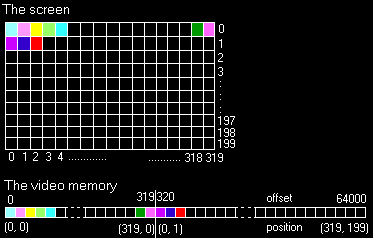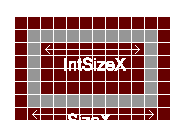
Graphics by Lord Azathoth

char far *vgamemory = (char *)0xA0000000L;or (on old compilators)
char far *vgamemory = (char *)MK_FP(0xA000, 0);But under DJGPP isn't so simple because the memory is protected, so you can't access directly to all the memory of the system. The best solution is to disable the protection of the DOS memory by calling the procedure
__djgpp_nearptr_enable(). There are a simple
code that shows how to access at the DOS memory:
#include <sys/nearptr.h> __djgpp_nearptr_enable(); vgamemory=(char *)(0xa0000 + __djgpp_conventional_base); __djgpp_nearptr_disable();The header
nearptr.h is necessary for the prototipes of the functions. We should
use __djgpp_conventional_base to get the right address of the DOS memory (the
protected mode is very intricate). At the end of the program, use __djgpp_nearptr_disable()
to get the program back to regular protected mode. But you must remember that with this
code you disable the protection of the memory, so you can damage the DOS area and block the
system. Use the program info (you must download the file txi390b.zip) for more
informations.
#define TEXT_MODE 0x03
#define VGA_MODE 0x13
void setmode(short mode)
{
union REGS regs;
regs.h.ah = 0x00; // Procedure 0x00: Set Video Mode
regs.h.al = mode; // The requested video mode
int86(0x10,®s,®s) // Call the BIOS
}
If you set the most significant bit of the register al (use 0x93 instead of 0x13)
the video memory is not cleared. If you don't like to use the BIOS you can download the file
modes.zip that explain
how to set the video mode without the BIOS. If you write a color byte at the start of the video memory (A000:0000) you'll show a pixel
at the upper-left corner of the screen (0, 0). When you write at the offset 319 (A000:013F)
you'll show a pixel at the upper right corner. Writing at the next byte (A000:0140) and the
pixel will appear at the position (0, 1). So we can understand that if we want to show a pixel
at the position (x, y) we must write at the address A000:(y*320+x) of the video memory. This is
a fast method for write a pixel. But we can optimize a bit the speed by using shifting instead
of multiplications. So we divide the number 320 into the powers of two 256 and 64 and we have
If you write a color byte at the start of the video memory (A000:0000) you'll show a pixel
at the upper-left corner of the screen (0, 0). When you write at the offset 319 (A000:013F)
you'll show a pixel at the upper right corner. Writing at the next byte (A000:0140) and the
pixel will appear at the position (0, 1). So we can understand that if we want to show a pixel
at the position (x, y) we must write at the address A000:(y*320+x) of the video memory. This is
a fast method for write a pixel. But we can optimize a bit the speed by using shifting instead
of multiplications. So we divide the number 320 into the powers of two 256 and 64 and we have
320y = 256y + 64y and next offset = (y<<8) + (y<<6)
+ x . For drawing a line we must calculate where an immaginary line intersect an immaginary rect.
For each square of the rect correspond a pixel on the screen. So for each square intersected by
a immaginary line we have a pixel of the real line to draw. We must calculate what squares
is intersected by the line. A simple method is by using the equation
For drawing a line we must calculate where an immaginary line intersect an immaginary rect.
For each square of the rect correspond a pixel on the screen. So for each square intersected by
a immaginary line we have a pixel of the real line to draw. We must calculate what squares
is intersected by the line. A simple method is by using the equation x-x1=m(y-y1)
, but is a bit slow. sizex/sizey=countx/county sizex and sizey are the sizes of the rectangle that contain the line countx and county are the counters impiegated by the algorithmso we have:
county * sizex calculatex= -------------- sizey countx * sizey calculatey= -------------- sizexBut the Bresenham's algorithm transform the equations for drawing the lines without the multiplications and the divisions. See the demo program for the code of the algorithm.
drawline() function and draw a rectangle
more faster. We know the structure of the video memory, so is simple to design an algorithm for
a rectangle.
draw sizex pixels from (x1, y1) onerow: jump 320-sizex pixels draw a pixel jump sizex-2 (intsizex) pixels draw a pixel while row drawed < sizey-2 jump 320-sizex pixel draw sizex pixelsSee the demo program for the code of the algorithm.
0..63, that specify the intensity of Red, Green and Blue. Whit the mixing
of these colors we can make the wanted color. The VGA card have 3 register for change the
palette: RGB_READ for telling the index of the color to read, RGB_WRITE for telling the index
of the color to write and RGB_DATA for read/write the RGB value. RGB_RESET is used for prepare
the VGA card (isn't necessary). The following code shows how to setting the RGB value of the
color 15 (WHITE):
#define RGB_RESET 0x03C6
#define RGB_READ 0x03C7
#define RGB_WRITE 0x03C8
#define RGB_DATA 0x03C9
void setwhite(void)
{
outp(RGB_RESET, 0xFF); // Prepare the VGA card
outp(RGB_WRITE, WHITE); // Tell that we want to write the color 15 (WHITE)
outp(RGB_DATA, 64); // Red value
outp(RGB_DATA, 64); // Green value
outp(RGB_DATA, 64); // Blue value
}
For setting all the 256 colors simply tell to the VGA card that we want to write the color 0,
and next write the RGB of all the colors:
void setpalette(char *palette)
{
register int i;
outp(RGB_RESET, 0xFF); // Prepare the VGA card
outp(RGB_WRITE, 0); // Tell that we want to write the entire palette
for(i=0;i<256;i++) {
outp(RGB_DATA, palette[i*3]); // Red value
outp(RGB_DATA, palette[i*3+1]); // Green value
outp(RGB_DATA, palette[i*3+2]); // Blue value
}
}
For reading the RGB value of a color or of all the colors simply write the index to RGB_READ and
read the values from RGB_DATA.See the demo program for the code.
void waitretrace(void)
{
// Wait vertical retrace
while(inportb(0x03DA)&0x08);
// Wait refresh
while(!(inportb(0x03DA)&0x08));
}